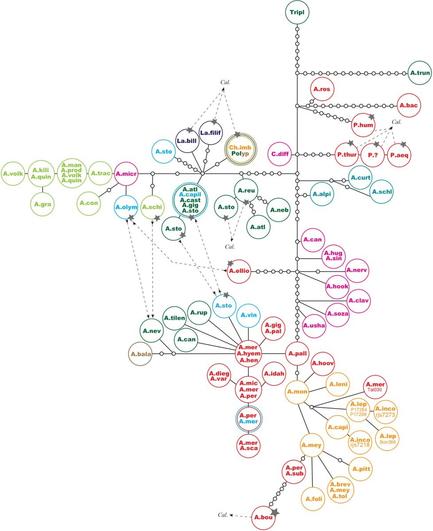Is the grass *always* greener on the other side?
Maybe Barberá et al. know! They certainly know a lot about #phylogenetics and #reticulation among koelerioid clades. Don't miss this fascinating #OpenAccess study published in #JSE!
https://doi.org/10.1111/jse.13133
@WileyEcolEvol
#PlantSci #evolution #botany
#reticulation
Peterson et al. investigate the #phylogeny, #biogeography, #reticulation, and #classification of Agrostis in their latest study published in #JSE!
Explore their #phylogeny right here!👇
https://doi.org/10.1111/jse.13175
@WileyEcolEvol
#PlantSci #systematics #evolution #ecology #grasses #botany
(7/7) And the winner was Crossroad.
To explain the genetic puzzle in the Philippines, we concluded that two of the genus' major lineages, one Pacific, one African-Asian populated the Philippines when they came in reach and found enough place (niches) to radiate there. In course of this (early) contact, inter-lineage mixing occured (#CoralOfLife #reticulation) leading to the modern-day genetic mosaic.
Towards that end, it may be worthwhile to explore the incongruent signals (see gCF results): what are the alternatives?
Between-gene incongruence and phylogenomic branch supports < 100 may relate to lack of discriminative signal (fast ancient radiations) and ILS. Or evidences evolutionary #reticulation
A dichotomous tree may simply be not comprehensive enough, for any group of plants #CoralOfLife
PS If you like to go down the rabbit hole of #reticulation, check out the (now dormant)
Genealogical World of Phylogenetic Networks
https://phylonetworks.blogspot.com/
Includes a few posts on viruses, too, especially towards the end. Teaser attached.
Are #grasses your thing?
How about #phylogenetics and #reticulation among koelerioid clades?
If you answered🤩to any of these, then today is your lucky day! Read part 1 of a new study from Barberá et al. in #JSE!
https://doi.org/10.1111/jse.13133
@WileyEcolEvol
#PlantSci #evolution #botany #OpenAccess

